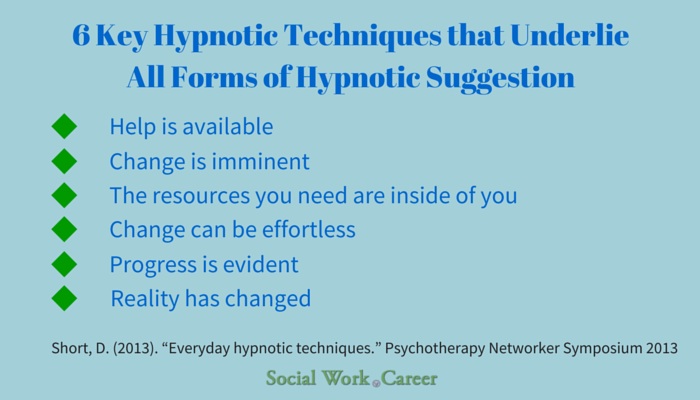Hypnosis can be an effective modality with a variety of symptoms such mood regulation, panic attacks, pain management and smoking cessation.
As per Dan Short, Ph.D., therapeutic hypnosis is a “collaborative exploration of possibility, as previously unrecognized resources and potentials are brought to awareness.” The primary objective of therapeutic hypnosis is for the benefit of a client’s wellbeing.
You may think that you need to be trained in induction methods to incorporate suggestive hypnotic techniques into your therapeutic practice, but that is not the case according to Short in his talk entitled: “Everyday Hypnotic Techniques” at the 2013 Psychotherapy Networker Symposium.
He provided two demonstrations in which he incorporated the 6 core suggestive messages that we are to apply in our work with clients vis a vis the problem with which they require our assistance.
The chart below provides a couple of Short’s suggestions as to how we may relay these thoughts; however, we may come up with alternate verbiage that feels more natural to us (and/or fitting the particular situation).
In addition to the above variation, he also demonstrated the hypnotic trance version. I found them both inspiring.
Hypnosis or hypnotic techniques essentially build upon the fact that people are very much influenced by the power of suggestion and this is seen in many different arenas from the Pygmalion effect to the Placebos and more except that here we are working with areas/symptoms that individuals would like to change and using their resources/ideas to tell them that they can alter their reality.
Through hypnotic suggestions, we are able to provide our clients with the encouragement, hope and possibility that they can overcome whatever obstacle they are facing and even if they cannot do so completely yet, they can/will very soon.
This class has definitely piqued my interest in the subject. What are your thoughts about hypnotic techniques? Do you find these a helpful tool to employ with your clients?
Reference: Short, D. (2013). “Everyday hypnotic techniques.” Psychotherapy Networker Symposium 2013




Hi Dorlee,
I’m reading an interesting book right now, called Mind Over Mind – The Surprising Power of Expectations. In summary, we often get, see, taste, hear, feel what we expect to get, see, taste, hear and feel.
We hear hypnotic suggestions all the time, but in a less formal way. At work,in advertising, at the doctor’s office, at school, or on the playing field. It’s also important to know that we’re filtering those suggestions, based on our preferences, our experiences and our willingness to learn, change and grow.
You asked if I used the hypnosis techniques I learned in my NLP course. I do in an informal way, much like Dan Short does.
Thanks for a mesmerizing post. 🙂
Hi Marianna,
The book you are reading sounds very interesting and apropos 🙂
Thank you for pointing out the important filtering “device” that we all have developed over time that impacts how receptive we are to receiving the various messages/suggestions we receive from others.
Thanks so much for your kind feedback and for sharing how you use hypnosis in your work !